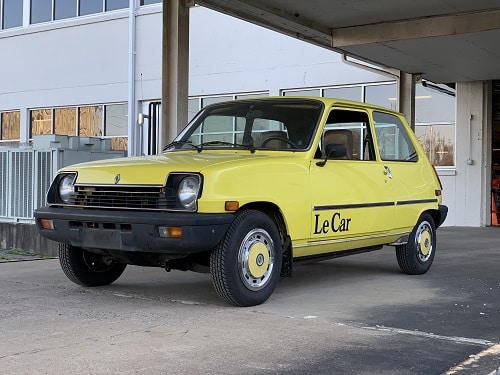
Renault Le Car- 1979
Launched in 1972, the R5 “supermini” hatchback was Renault’s answer to Fiat’s 127. Small, three-door front-wheel drive hatchbacks were the new “thing” at the time. A variety of engines...
DAILY DEMONSTRATIONS AT 11AM, FREE WITH ADMISSION!
Please note that the cars or exhibit items shown in this database are part of our collection but may not be on display when you visit.
Launched in 1972, the R5 “supermini” hatchback was Renault’s answer to Fiat’s 127. Small, three-door front-wheel drive hatchbacks were the new “thing” at the time. A variety of engines...
Renaultsport was formed in the late 1940s to run Renault’s racing programs. Throughout the years, they have made many different limited-edition vehicles based off standard Renault models. The...
The Renault 16 (known colloquially as the R16) was a forward-looking car. Before the term “hatchback” was coined, the R16 was the first medium-sized front-wheel-drive family car, simply called...
Looking at the Spider, you will see that it is a completely different car from the other Renaults you have seen. It is a stark open 2-seater similar...
The Twingo debuted at the Paris Motor Show in October 1992 and went into production in April 1993. This first year Twingo is a fantastic example of a first-generation...
Renault brothers Louis, Marcel, and Fernand founded Renault as Société Renault Frères in 1898. Their first Renault car was the A-Type Voiturette 1CV, fitted with a De Dion-Bouton-supplied, single-cylinder...
Deutsch-Bonnet was a partnership between Charles Deutsch and Rene Bonnet that began in 1938 to build race cars. D-B cars were very successful on the racing circuit and dominated...
In 1954, PlastiCar, Incorporated of Doylestown, PA. introduced two plastic body sports cars; one roadster, the Rogue, and one hardtop, the Marquis (note: the Marquis was also available as...
This company began in 1938 under the name New-Map and was better known for manufacturing motorcycles. While the microcar was somewhat of a novelty, it quickly found favor in...
Robert and Raul de Rovin began building cyclecars and motorcycles in the 1920s. After World War II ended, the French government encouraged the development of economy cars to get...
Founded in 1937, Saab AB, “Svenska Aeroplan Aktiebolaget” (Swedish for “Swedish Aeroplane Corporation”), made aircraft for Sweden’s air force during World War II, as the country defended its neutrality....
Beginning in the early 1950s, many amateur race cars were nothing more than a street car with some limited modifications. Competitors often drove their cars to the track, raced,...
Saab’s Model 93, introduced Dec. 1, 1955, was only the company’s second automotive model, and was the first to be exported in significant numbers – most came to the...
Saab began as developers of airplanes. After World War II, it was obvious that air transportation might not become commercially viable for decades. Saab began looking for an alternative...
The Saab 96 was presented at a Stockholm press conference on February 17, 1960. It was well received and proved popular. In 1967, Saab considered making the 96 model...
The Saab 96 was presented at a Stockholm press conference on February 17, 1960. It was well received and proved popular. The 96 was not completely new–you will notice...
Introduced as the Sonett II in 1966 with a comparatively different-looking fiberglass body, the Saab 97, or Sonett III, seen here was redesigned for the 1972 model year. The...
The Sonett was originally designed as a race car. The Sonett I was produced from 1955 to 1957, and only six were built. In 1966 Saab resurrected the...
The Sabra Sport was Israel’s first foray into the world of sports cars; parent company Autocars Co. Ltd. had been established as Israel’s first auto and light commercial vehicle...
Entreposto Comercial SA was founded in Portugal in 1967 with the aim of importing, assembling, and retailing Datsun vehicles (now Nissan), marking its entry into Portugal’s automotive industry. However,...
Marian Kotlicki, an airplane mechanic and an aviation enthusiast who lived in Poland, owned five cars in his lifetime. He built each one himself. His creations ranged from a...
Envisioned by Louis Bertetto, president of the Automobile Club Milano, and Romulus Tavoni, former sporting director for Ferrari, as an entry-level racing formula in 1964, Formula Monza 875 was...
Parisian racer and auto enthusiast Jean-Claude Hrubon created this shortened version of the Mini Moke. Mr. Hrubon started production in 1980, but quickly sold the manufacturing rights in 1981...
It may seem hard to believe, but the manufacturer of the Scootacar also produced railroad locomotives. The Scootacar was developed in 1957 by the Hunslet Engine Works of Leeds,...
It may seem hard to believe, but the manufacturer of the Scootacar also produced railroad locomotives. The Scootacar was developed in 1957 by the Hunslet Engine Works of Leeds,...
SEAB (Societe d’Exploitation et d’Application des Brevet) was perhaps best-known as the manufacturer of the plastic bodies used on Citroën’s Mehari, but they later became a manufacturer of vehicules...
The number of vehicles on our world’s roads are expected to triple by 2050. This will require some new thinking and innovation with a variety of fuels and technology...
The car seen here is one-of-one; it was designed, built, and raced by Frazier Sibbald, George Olsen, and Howard Bliss, all of California. Sibbald was the racer, Olsen the...